747 Shuttle Carrier Aircraft Delivers Space
Shuttle Columbia to Palmdale, September 25, 1999
(Download a higher resolution picture by clicking on any
picture below.)
 The space shuttle orbiter Columbia,
OV-102 was delivered to Air Force Plant 42 at Palmdale,
California on Saturday, September 25, 1999 on the back of a
Boeing 747 Shuttle Carrier Aircraft (SCA). It was housed at
Boeing's Orbiter Assembly Facility during an eightteen-month
orbiter maintenance down period.
The space shuttle orbiter Columbia,
OV-102 was delivered to Air Force Plant 42 at Palmdale,
California on Saturday, September 25, 1999 on the back of a
Boeing 747 Shuttle Carrier Aircraft (SCA). It was housed at
Boeing's Orbiter Assembly Facility during an eightteen-month
orbiter maintenance down period.
 The Columbia was preceded by NASA's C-135A,
N931NA, Weightless
Wonder V. The fragile thermal protection system tiles
cannot be flown through rain, so the C-135A acts as a weather
pathfinder.
The Columbia was preceded by NASA's C-135A,
N931NA, Weightless
Wonder V. The fragile thermal protection system tiles
cannot be flown through rain, so the C-135A acts as a weather
pathfinder.
 Weightless Wonder V flies ahead of the 747-SCA to scout for any
precipitation. On this flight, the weather in New Mexico
postponed the second leg of the flight for one day. The 747-SCA
stayed overnight at Whiteman Air Force Base in Kansas.
Weightless Wonder V flies ahead of the 747-SCA to scout for any
precipitation. On this flight, the weather in New Mexico
postponed the second leg of the flight for one day. The 747-SCA
stayed overnight at Whiteman Air Force Base in Kansas.
 Weightless
Wonder V is used to provide astronaut trainees experience
with the effects of zero-G. By following a ballistic trajectory,
about a half minute of zero-G can be experienced. The result on
astronaut trainees of a long series of such arcs has earned this
airplane the nickname of "Vomet Comet". It is normally
based at the Johnson
Space Center in Houston, Texas.
Weightless
Wonder V is used to provide astronaut trainees experience
with the effects of zero-G. By following a ballistic trajectory,
about a half minute of zero-G can be experienced. The result on
astronaut trainees of a long series of such arcs has earned this
airplane the nickname of "Vomet Comet". It is normally
based at the Johnson
Space Center in Houston, Texas.
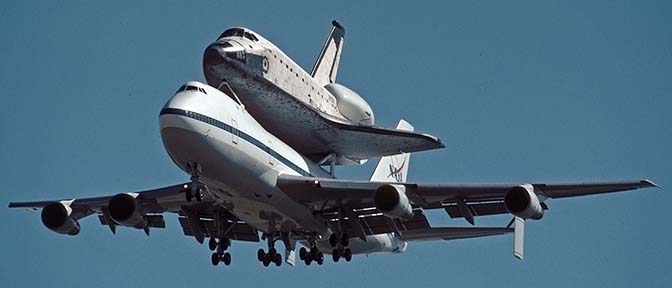 Space
Shuttle Columbia arrived at Air
Force Plant 42 shortly after 10:00 A. M. It had made low
passes over NASA's
Dryden Flight Research Center at Edwards Air Force Base and
Fox Field, west of Lancaster. For a moment, the 747-SCA, N905NA
was handed off to the Fox Field tower by Joshua Control.
Space
Shuttle Columbia arrived at Air
Force Plant 42 shortly after 10:00 A. M. It had made low
passes over NASA's
Dryden Flight Research Center at Edwards Air Force Base and
Fox Field, west of Lancaster. For a moment, the 747-SCA, N905NA
was handed off to the Fox Field tower by Joshua Control.
 The
747-SCA circled at low altitude over the city of Lancaster and
paraded around the Antelope Valley before lining up on Runway 25.
Astronaut Gordon Fullerton was at the controls of the 747-SCA.
The
747-SCA circled at low altitude over the city of Lancaster and
paraded around the Antelope Valley before lining up on Runway 25.
Astronaut Gordon Fullerton was at the controls of the 747-SCA.
 You can buy framed prints or greeting cards of this photograph.
You can buy framed prints or greeting cards of this photograph.
 Imagine my surprise to discover this frame in an Evergreen International promotional video for the 747 supertanker on YouTube. .
Imagine my surprise to discover this frame in an Evergreen International promotional video for the 747 supertanker on YouTube. .
 According to a NASA press release from the
time:
According to a NASA press release from the
time:
The Space
Shuttle Columbia will be outfitted with the
multi-functional electronic display system (MEDS) or
"glass cockpit". The new system improves crew
interaction with the orbiter during flight and reduces the
high cost of maintaining the outdated electromechanical
cockpit displays currently onboard.
While her sister ships are being outfitted with external
airlocks in support of the International Space Station
assembly, Columbia's internal airlock will not be removed
during this OMDP. Thus, Columbia will continue to be able to
accommodate payloads requiring the orbiter's 60-foot long
cargo bay. Though not currently slated to dock with the
International Space Station, Columbia will be given
additional wire harnesses and connectors while at Palmdale to
allow installation of the Orbiter Docking System at Kennedy
Space Center. This prepares Columbia for docking operations
with the space station if plans change.
While at Palmdale, Columbia's 100 miles of wiring will be
given a thorough inspection. This is part of NASA's fleet
wide wiring inspection. The wiring problem was first
identified on Columbia as a result of the STS-93 mission.
Preparation work for an enhanced Global Positioning
Satellite system capability will also be performed on
Columbia. When installed, the new system will more accurately
pinpoint the orbiter's location in flight. A space-to-space
orbiter radio and wireless video modification will increase
communication capabilities for Columbia's future crew members
and space walkers. In addition to scheduled weight saving
modifications, Columbia's radiators or coolant lines will be
enhanced for protection from orbital debris.
 The space shuttle Columbia
was expected to be at Palmdale for about nine months. It was
scheduled to return to the Kennedy
Space Center the following July.
The space shuttle Columbia
was expected to be at Palmdale for about nine months. It was
scheduled to return to the Kennedy
Space Center the following July.

 Twenty years ago, on March 20, 1979, Columbia
departed from Runway 04 at Edwards Air Force Base on 747-SCA
N905NA on its delivery flight
to the Kennedy Space Center. There was still a lot of work to
be done on the installation of thermal protection system tiles.
The American Airlines heritage of the 747-SCA was still evident.
Twenty years ago, on March 20, 1979, Columbia
departed from Runway 04 at Edwards Air Force Base on 747-SCA
N905NA on its delivery flight
to the Kennedy Space Center. There was still a lot of work to
be done on the installation of thermal protection system tiles.
The American Airlines heritage of the 747-SCA was still evident.
More Space Shuttle photos
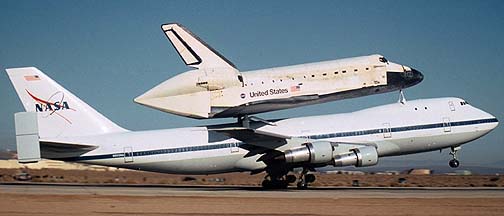 More pictures from Space Shuttle events.
More pictures from Space Shuttle events.
More Edwards Air Force Base displays
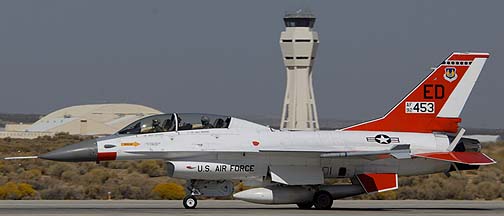 Edwards AFB displays.
Edwards AFB displays.
- advertisement -
Shuttle Carrier Aircraft
2020 calendar
You can buy a 2020 calendar
featuring my photographs of Space Shuttle Carrier Aircraft.
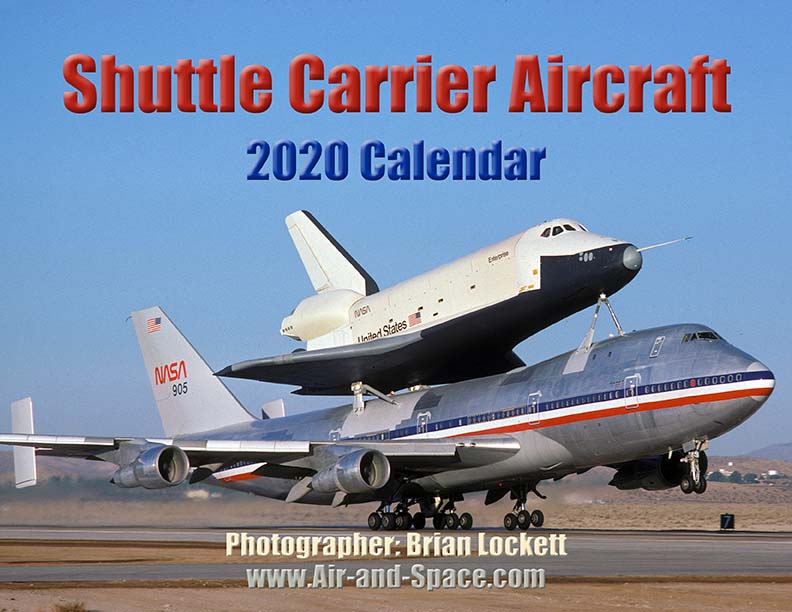
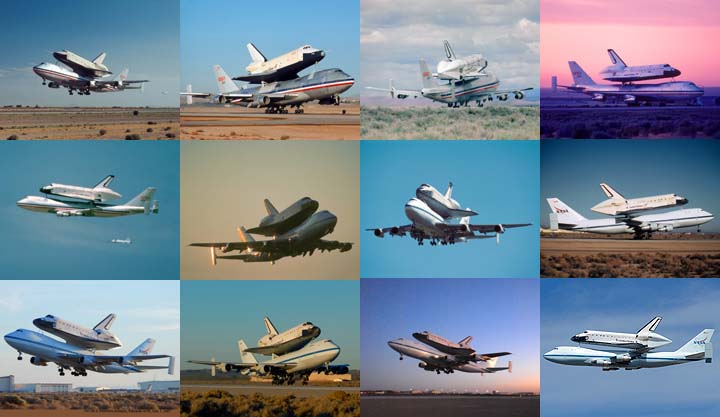
A dozen photos of 747 Shuttle Carrier Aircraft. Events depicted include:
747-SCA N905NA/Enterprise Approach and Landing Test 1 take-off on August 12, 1977.
747-SCA N905NA/Enterprise Approach and Landing Test 4 take-off on October 12, 1977.
747-SCA N905NA/Columbia delivery take-off on March 20, 1979.
747-SCA N905NA/Challenger static and departure take-off on July 4, 1982.
747-SCA N911NA/Endeavor delivery take-off from Palmdale on May 2, 1991.
747-SCA N905NA/Columbia landing at Palmdale on September 25, 1999.
747-SCA N905NA/Discovery take-off on November 2, 2000.
747-SCA N905NA/Atlantis take-off on July 1, 2007.
747-SCA N911NA/Endeavor take-off on December 10, 2008.
747-SCA N911NA/Discovery take-off on September 20, 2009.
747-SCA N905NA/Endeavor flyover at LAX, September 21, 2012.
 Put a copy of the Shuttle Carrier Aircraft 2020 calendar in your Lulu.com shopping cart for $14.95.
Put a copy of the Shuttle Carrier Aircraft 2020 calendar in your Lulu.com shopping cart for $14.95.
Space Shuttle Endeavour at Edwards Air Force Base
2020 calendar
You can buy a 2020 calendar
featuring my photographs of Space Shuttle Endeavour at Edwards Air Force Base.
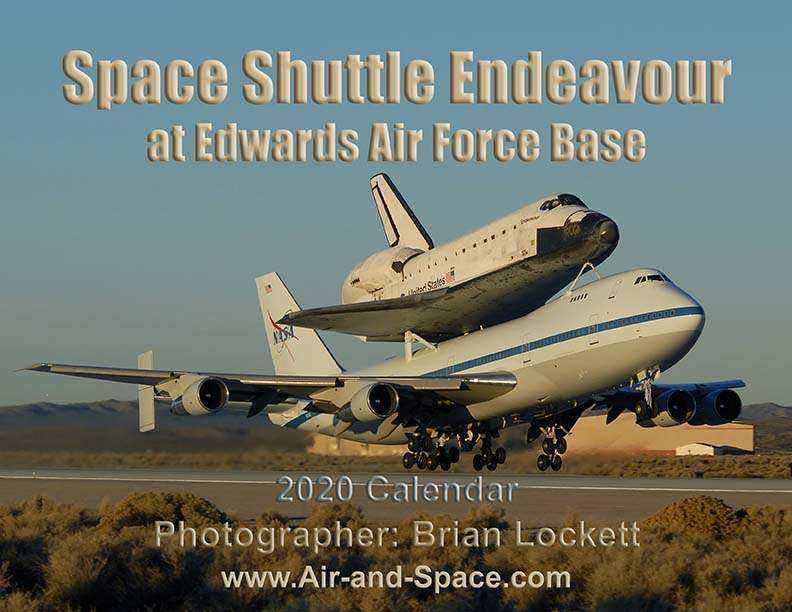

Bad weather caused the Space shuttle Endeavour to divert to Edwards Air Force Base at the conclusion of STS-126 on November 30, 2007. Following servicing in the Mate/Demate Device, it departed from Edwards on the back of 747 Carrier Aircraft N911NA on December 10.
 Put a copy of the Space Shuttle Endeavour at Edwards Air Force Base: 2020 calendar in your Lulu.com shopping cart for $14.95.
Put a copy of the Space Shuttle Endeavour at Edwards Air Force Base: 2020 calendar in your Lulu.com shopping cart for $14.95.
Space Shuttle Discovery at Edwards Air Force Base
2020 calendar
You can buy a 2020 calendar
featuring my photographs of Space Shuttle Discovery at Edwards Air Force Base.
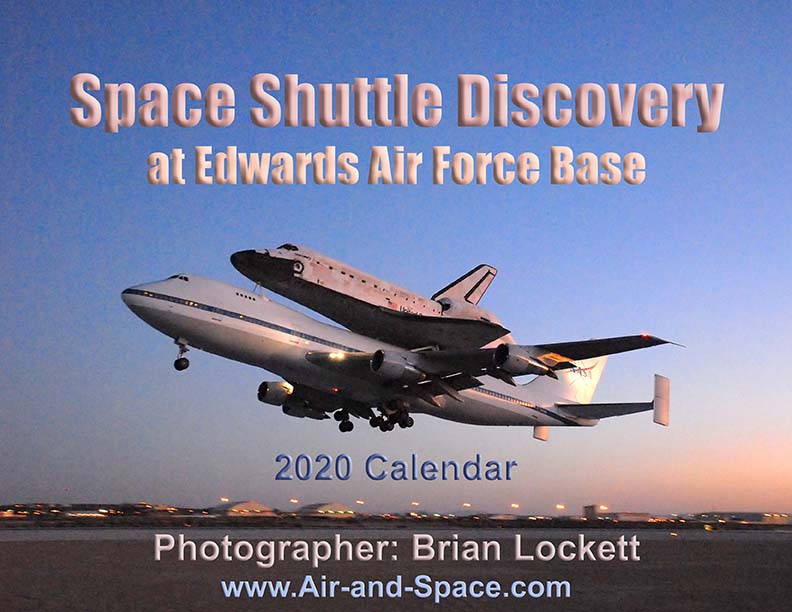

A dozen photographs of the Space Shuttle Discovery at Edwards Air Force Base. Bad weather at the Kennedy Space Center caused the Space shuttle Discovery to divert to Edwards Air Force Base at the conclusion of mission STS-128 on September 11, 2009. Following servicing in the Mate/Demate Device, it departed from Edwards on the back of 747 Carrier Aircraft N911NA on September 20.
 Put a copy of the Space Shuttle Discovery at Edwards Air Force Base: 2020 calendar in your Lulu.com shopping cart for $14.95.
Put a copy of the Space Shuttle Discovery at Edwards Air Force Base: 2020 calendar in your Lulu.com shopping cart for $14.95.
Space Shuttle Endeavour's Final Flights
2020 calendar
You can buy a 2020 calendar
featuring my photographs of Space Shuttle Endeavour's Final Flights.

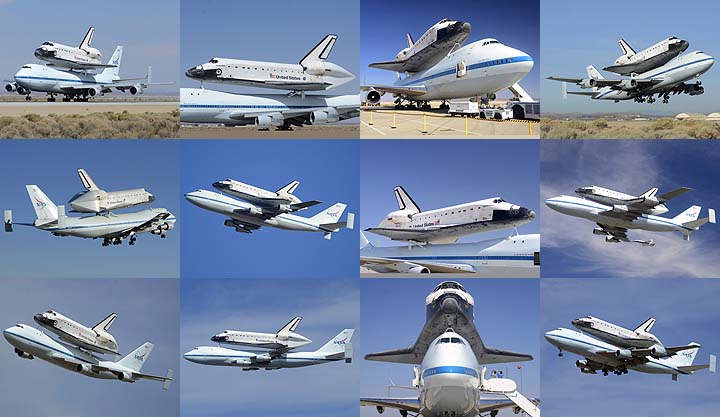
A dozen photos of Space Shuttle Endeavour's Final Flights. Boeing 747-Shuttle Carrier Aircraft N905NA and Space Shuttle Endeavour arrived at Edwards Air Force Base from Biggs Army Airfield on September 20, 2012. The pair were placed on static display at the NASA Dryden Flight Research Center that afternoon. The 747/Shuttle stack departed from Edwards Air Force Base on the morning of September 21. It toured California and several landmarks in the LA Basin. It made two low passes over Los Angeles International Airport before making its final landing. The 747-SCA was flown to Edwards Air Force Base on September 24 where it was retired. The Endeavour ison display at the California Science Center.
 Put a copy of the Space Shuttle Endeavour's Final Flights 2020 calendar in your Lulu.com shopping cart for $14.95.
Put a copy of the Space Shuttle Endeavour's Final Flights 2020 calendar in your Lulu.com shopping cart for $14.95.
- advertisement -
Books and Videos about the Space Shuttle from Amazon.com
|
Books
|
|
|
|
|
|
|
|
DVDs
|
|
|
|
|
|
|
|
Visit the Lockett Books Amazon Webstore for a selection of aviation and space related books and DVDs. 
|
|
- advertisement -

Send a message to Brian.
 The space shuttle orbiter Columbia,
OV-102 was delivered to Air Force Plant 42 at Palmdale,
California on Saturday, September 25, 1999 on the back of a
Boeing 747 Shuttle Carrier Aircraft (SCA). It was housed at
Boeing's Orbiter Assembly Facility during an eightteen-month
orbiter maintenance down period.
The space shuttle orbiter Columbia,
OV-102 was delivered to Air Force Plant 42 at Palmdale,
California on Saturday, September 25, 1999 on the back of a
Boeing 747 Shuttle Carrier Aircraft (SCA). It was housed at
Boeing's Orbiter Assembly Facility during an eightteen-month
orbiter maintenance down period.




 Imagine my surprise to discover this frame in an Evergreen International promotional video for the 747 supertanker on YouTube. .
Imagine my surprise to discover this frame in an Evergreen International promotional video for the 747 supertanker on YouTube. .


 Twenty years ago, on March 20, 1979, Columbia
departed from Runway 04 at Edwards Air Force Base on 747-SCA
N905NA on its delivery flight
to the Kennedy Space Center. There was still a lot of work to
be done on the installation of thermal protection system tiles.
The American Airlines heritage of the 747-SCA was still evident.
Twenty years ago, on March 20, 1979, Columbia
departed from Runway 04 at Edwards Air Force Base on 747-SCA
N905NA on its delivery flight
to the Kennedy Space Center. There was still a lot of work to
be done on the installation of thermal protection system tiles.
The American Airlines heritage of the 747-SCA was still evident.



 Put a copy of the Shuttle Carrier Aircraft 2020 calendar in your Lulu.com shopping cart for $14.95.
Put a copy of the Shuttle Carrier Aircraft 2020 calendar in your Lulu.com shopping cart for $14.95.






